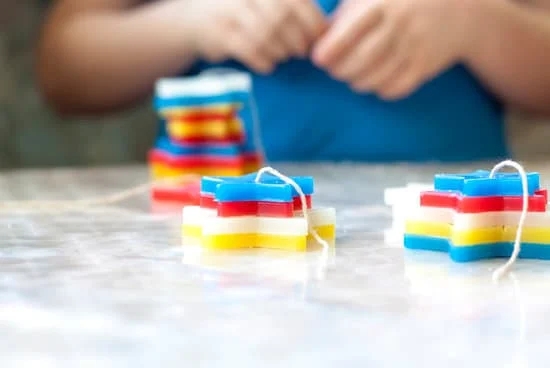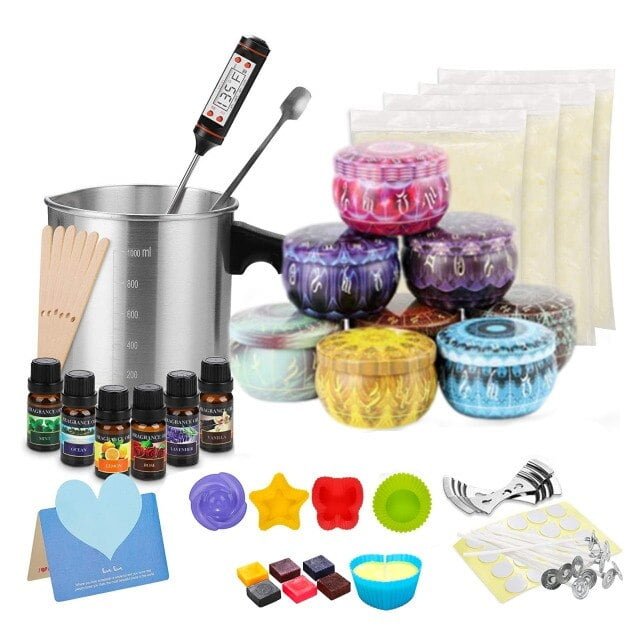Wood wicks for making candles have become increasingly popular among candle makers for their unique aesthetic appeal and soothing crackling sound. As artisans seek innovative ways to elevate their craft, the use of wood wicks has emerged as a charming and distinctive choice in candle making. In this article, we will delve into the world of wood wicks, exploring their characteristics, benefits, and how to incorporate them seamlessly into your candle creations.
As the demand for natural and eco-friendly products grows, wood wicks have gained traction for their sustainable properties. Unlike traditional cotton wicks, wood wicks are made from a combination of natural wooden materials like cherry or cedar. This sets them apart by offering a clean-burning alternative that not only enhances the ambiance but also aligns with environmentally conscious practices.
Beyond their environmental benefits, wood wicks also provide a rustic touch to candles that adds warmth and character to any space. The crackling sound produced as the flame dances along the wooden surface creates a cozy atmosphere reminiscent of a crackling fireplace. With their distinct appearance and soothing acoustics, wood wicks offer a sensory experience that elevates the art of candle making to new heights.
What Are Wood Wicks and How Do They Differ From Traditional Wicks?
Wood wicks have been gaining popularity in candle making for their unique qualities and aesthetic appeal. Unlike traditional cotton wicks, wood wicks are made from a combination of natural wood fibers and textile yarns. This composition allows wood wicks to create a soothing crackling sound reminiscent of a cozy fireplace, adding an extra sensory experience to the ambiance created by the candle.
What Makes Wood Wicks Different?
One of the key differences between wood wicks and traditional wicks is the way they burn. Wood wicks have a wider flame compared to cotton wicks, providing a more even melt pool and stronger fragrance throw. Additionally, wood wicks require less trimming than cotton wicks, making them easier to maintain during the burn process. The distinct crackling sound produced by wood wicks also adds a touch of relaxation and comfort to any environment.
Environmental Benefits of Wood Wicks
Another important aspect that sets wood wicks apart is their eco-friendly nature. As renewable resources, wood wicks offer a sustainable alternative to traditional cotton or synthetic wicks. By choosing wood wicks for candle making, crafters can reduce their environmental impact and support responsible sourcing practices. Moreover, the natural characteristics of wood contribute to cleaner burns with minimal soot or residue, promoting a healthier indoor air quality compared to candles with conventional wicks.
Benefits of Using Wood Wicks in Candle Making
Wood wicks for making candles have gained popularity in the candle-making community due to their unique characteristics and benefits. One of the main advantages of using wood wicks is the aesthetic appeal they provide to candles.
The crackling sound produced by burning wood wicks creates a cozy ambiance, reminiscent of a fireplace, adding an extra touch of warmth to any space. Additionally, wood wicks are visually appealing and can enhance the overall look of a candle, especially in rustic or natural-themed designs.
Another benefit of using wood wicks in candle making is their clean burn. Wood wicks are known for producing minimal soot compared to traditional cotton wicks, resulting in a cleaner and healthier environment when burning candles. This clean burn also means less maintenance for candle users since there is reduced residue left behind on container walls or surfaces. Moreover, wood wicks typically have a slower burn rate than cotton wicks, contributing to an extended burning time for candles.
Furthermore, wood wicks offer excellent fragrance throw in candles. The wide base and open flame characteristic of wood wicks allow for better diffusion of fragrance oils throughout the wax pool, resulting in a stronger scent throw when the candle is burning. This means that candles made with wood wicks not only look and sound delightful but also fill the room with captivating scents, creating a more immersive sensory experience for users.
Types of Wood Wicks Available for Candle Making
Wood wicks are an increasingly popular choice for candle makers looking to add a unique touch to their creations. When it comes to selecting wood wicks for making candles, there are several types available on the market to choose from. One of the most common types is the straight-cut wood wick, which provides a clean and consistent burn. Another option is the curved or multi-layered wood wick, which can create a more aesthetic appeal with its unique design.
In addition to the shape and style of wood wicks, another factor to consider is the type of wood used. Some popular choices include cherry, maple, and birch wood wicks, each offering their own distinct characteristics when it comes to burning performance and aroma diffusion. For example, cherry wood wicks are known for their long-lasting burn and crackling sound when lit, adding an extra sensory element to your candle experience.
To help you choose the right type of wood wick for your candle making project, it’s essential to consider factors such as the size of your container, the type of wax you’re using, and the desired burn time of your candle. Experimenting with different types of wood wicks can also be a fun way to explore new creative possibilities in your candle making process.
Whether you prefer a classic straight-cut wood wick or a more unique curved design, incorporating wood wicks into your candles can elevate them to a whole new level of elegance and charm.
| Type of Wood Wick | Main Characteristics |
|---|---|
| Straight-Cut Wood Wick | Clean and consistent burn |
| Curved or Multi-Layered Wood Wick | Unique aesthetic appeal |
| Cherry Wood Wick | Long-lasting burn and crackling sound |
How to Properly Prepare and Use Wood Wicks in Candle Making
Wood wicks have become increasingly popular in the world of candle making due to their unique aesthetic appeal and crackling sound when burning. However, using wood wicks properly is key to ensuring a successful candle-making experience. In this section, we will explore the essential steps to prepare and use wood wicks effectively in your candle making process.
Choosing the Right Size and Type of Wood Wicks
Before you begin using wood wicks in your candles, it is crucial to select the appropriate size and type for your specific candle-making project. Wood wicks come in various sizes and thicknesses to accommodate different candle sizes and types of wax. It is recommended to refer to the manufacturer’s guidelines or conduct some testing to determine the best fit for your candles.
Preparing Wood Wicks for Candle Making
To ensure a clean burn and optimal fragrance throw, you must properly prepare your wood wicks before incorporating them into your candles. Trim the wood wick to the desired length based on the size of your container or mold. Some wood wicks may require priming before use, which involves dipping them in melted wax to create a stable base for burning. Follow the instructions provided by the wood wick manufacturer for priming techniques.
Properly Using Wood Wicks in Your Candle-Making Process
When adding wood wicks to your candle containers or molds, make sure they are centered and secured in place before pouring the melted wax. Use adhesive tabs or glue dots to hold the wood wick in position until the wax sets.
As you pour the wax, avoid overfilling the container as this can lead to uneven burning and potential safety hazards. Allow the candles to cool and cure according to the recommended timeframe before trimming the wood wick as needed for subsequent burns.
By following these guidelines for preparing and using wood wicks in your candle-making projects, you can enhance both the visual appeal and performance of your homemade candles. Experiment with different types of wood wicks to discover which ones work best for your unique creations, whether you prefer a slow-burning ambiance or a faster fragrance release. With proper care and attention, wood wicks can elevate your candle-making journey to new heights of creativity and satisfaction.
Tips and Tricks for Achieving the Perfect Burn With Wood Wicks
When it comes to achieving the perfect burn with wood wicks for making candles, there are several tips and tricks that can help ensure you get the most out of this unique wick option. Here are some helpful suggestions to consider:
- Trim the Wood Wick: It’s important to trim your wood wick to the recommended length before each use. This will help prevent any mushrooming at the top of the wick and promote a cleaner, more even burn.
- Properly Place the Wick: Make sure the wood wick is centered in your candle container before pouring the wax. A centered wick will allow for an even burn and prevent any tunneling issues.
- Use the Right Container: Opt for a container with a wide enough diameter to accommodate the size of your wood wick. This will allow for proper air circulation around the wick and help maintain a consistent burn.
In addition to these tips, it’s also essential to consider the type of wax and fragrance oils you are using in conjunction with wood wicks. Some fragrances may perform better with wood wicks compared to cotton or other types of wicks, so be sure to test different combinations to find what works best for your candles.
Remember that practice makes perfect when it comes to working with wood wicks. Experiment with different techniques and methods until you find what yields the desired results in terms of burn quality, scent throw, and overall performance in your candles. By following these tips and tricks, you’ll be well on your way to achieving beautiful and successful candles using wood wicks.
Common Mistakes to Avoid When Using Wood Wicks in Candle Making
When using wood wicks for making candles, it’s essential to be aware of common mistakes that can affect the quality and performance of your finished product. By avoiding these errors, you can ensure that your candles burn evenly and effectively, providing a delightful experience for anyone who enjoys them.
Here are some common mistakes to steer clear of:
- Not properly priming the wood wick before use: One mistake many beginners make is not priming the wood wick before pouring their candle wax. Priming involves soaking the wick in melted wax for a few minutes to ensure a more consistent and steady burn.
- Choosing the wrong size of wood wick: Selecting the correct size of wood wick for your candle is crucial. Using a wick that is too small can result in tunneling, where only the center of the candle burns, while a wick that is too large may cause smoking or uneven burning.
- Adding fragrance oils at high temperatures: When incorporating fragrance oils into your candle wax, be sure to do so at the recommended temperature. Adding oils at too high a temperature can lead to the scent evaporating or becoming distorted, impacting the overall quality of your candle.
By being mindful of these common mistakes and taking the necessary steps to avoid them, you can enhance your candle making skills and create beautiful products with wood wicks that are both visually appealing and aromatic.
Exploring Creative Designs and Ideas for Incorporating Wood Wicks in Candles
Wood wicks have become increasingly popular in candle making due to their unique aesthetic appeal and soothing crackling sound when lit. But beyond just their functionality, wood wicks also offer a wide range of creative design possibilities for candle makers looking to add an extra touch of charm to their products.
One creative idea for incorporating wood wicks in candles is to experiment with different sizes and shapes of the wick itself. By using thicker or thinner cuts of wood wicks, you can create varying burn times and flame sizes, allowing for customization based on the type of candle you are making. Additionally, playing around with different lengths of wood wicks can result in visually striking candles that stand out amongst traditional counterparts.
Another innovative way to use wood wicks in candles is by combining them with other natural materials such as dried flowers, herbs, or gemstones. Embedding these elements into the wax surrounding the wood wick can create a beautiful and fragrant centerpiece once the candle is burning. This not only adds a decorative element to your candles but also infuses them with unique scents and energies, enhancing the overall sensory experience for users.
Furthermore, considering unconventional vessel choices for your candles can elevate the overall look and feel of your creations when paired with wood wicks. From recycled glass jars to vintage teacups or even hollowed-out pieces of fruit, there are endless possibilities for showcasing your candles in a distinctive manner that highlights the beauty of both the wood wick and the candle itself.
By thinking outside the box and exploring various design ideas, you can truly make your candle creations stand out in a crowded market.
Conclusion
In conclusion, incorporating wood wicks into your candle making process can truly elevate the beauty and charm of your creations. The unique crackling sound and aesthetic appeal that wood wicks provide add a touch of warmth and coziness to any room. By choosing wood wicks for making candles, you are not only indulging in a sensory experience but also embracing a sustainable and eco-friendly option.
One of the key advantages of using wood wicks in candle making is their clean burn and minimal soot production. This not only ensures a longer-lasting candle but also promotes a healthier environment for you and your loved ones. Additionally, the variety of wood wick types available allows you to customize your candles according to your desired burn time, size, and fragrance throw.
As you continue on your candle making journey with wood wicks, remember to properly prepare and maintain them for optimal performance. Experiment with different designs and creative ideas to enhance the visual appeal of your candles while enjoying the calming ambiance they create when lit. Embrace the versatility and craftsmanship that wood wicks offer, and let them be an integral part of your candle making repertoire.
Frequently Asked Questions
Are Wood Wicks Better for Candles?
Wood wicks offer a unique aesthetic and soothing crackling sound when burning, making them popular among candle enthusiasts. They also tend to produce less soot compared to cotton wicks, resulting in a cleaner burn experience.
What Wood Makes a Good Candle Wick?
When it comes to choosing the best wood for candle wicks, untreated natural woods like cherry, cedar, or maple are ideal choices. These woods have natural properties that make them great at absorbing and distributing the melted wax evenly while burning steadily without mushrooming.
What Is the Best Wick to Use When Making Candles?
The best wick for making candles ultimately depends on the type of wax used and the size of the candle being made. For soy or beeswax candles, cotton wicks are commonly recommended due to their excellent burn performance and minimal smoke output. It’s important to match the wick size with the diameter of the candle for optimal burning results.

Welcome to my candle making blog! In this blog, I will be sharing my tips and tricks for making candles. I will also be sharing some of my favorite recipes.





